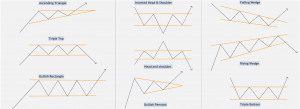Disclaimer: The opinions expressed here are for general informational purposes only and are not intended to provide specific advice or recommendations for any specific security or investment product. You should never invest money that you cannot afford to lose. Before trading using complex financial products, please ensure to understand the risks involved. Past performance is no guarantee of future results.
Table of contents:
- What is diversification?
- Process of diversification on Tuned
- Understanding the risk to reward ratio of strategies and syndications
- Know your risk tolerance
- Choosing a mix of high and low risk strategies
- The monitoring and rebalancing process
- Conclusion
What Is diversification?
Diversification is the act of spreading your investments across various asset classes and instruments like stocks, bonds, personal businesses, cryptocurrencies, etc. This process is done to minimize the risk of losses in the case of negative changes.
Diversification is pretty straightforward in traditional markets, given the breadth of industries and growth opportunities. The challenge with cryptocurrency markets is that many assets move in conjunction with each other. That’s to say, if Bitcoin falls, other coins are almost certain to follow.
Tuned helps solve this by offering investors exposure to a variety of strategies and market types. So that during turbulent times, when HODL becomes mantra, we can provide the tools that reduce worry.
With a diversified portfolio, our options are improved, we can stop the strategies which are not performing optimally or re-balance capital between strategies. Diversification helps an investor spend less time monitoring their portfolio, especially when the portfolio is being managed by automated trading bots.
Process of diversification on Tuned
Starting broad, let’s assume you have access to most or all crypto exchanges. You may initially ask, what’s the best exchange? This alone isn’t an easy question to answer, since things are constantly evolving. We can say though that each of our integrated exchanges sees high enough trading volume that your strategies won’t run into any liquidity problems.
The next question becomes what type of markets do you want to participate in? Spot markets, simple buying and selling, lets you ride waves up and is considered the safest. Futures markets expand opportunities for profits but are inherently more risky. Then there are Coin-Margined Futures, where traders prioritize the accumulation of the asset they’re trading over say USD or EUR profits.
With all these options available how do you evaluate them?
Understanding the risk to reward ratio of strategies and syndications
Understanding the risk/reward ratio (R/R ratio or R) is an important aspect before investing in any strategy. This represents how much a trader is willing to lose for a potential gain. For example: If you have a risk-reward ratio of 1:3, it means you’re risking $1 to potentially make $3. If you have a risk-reward ratio of 1:5, it means you’re risking $1 to potentially make $5. The Sharpe ratio is commonly used to assess the risk/reward ratio of the strategy. It quantifies how much return you can achieve for the level of volatility endured by the equity curve.
At Tuned, we have Risk Score as a metric that can give an idea of how well a strategy is doing, or how it has performed in the past by looking at backtest results.
Risk Score = %Average Monthly Profit x (1-MDD)^2
Let’s compare two strategies, Strategy A and Strategy B. The first strategy is considered as one with a high risk/reward ratio. On the other hand, the second strategy is considered a low risk/reward ratio strategy. Strategy A would be an option for an investor who’s willing to endure higher draw downs, also known as, higher risk tolerance. On the other hand, Strategy B will be chosen by someone who has a low risk tolerance.
Strategy A:
Risk score: 5.4%
Live performance: 6-8 months
Average Monthly Return: 15%
Max Draw Down: 40%
Strategy B:
Risk score: 6.4%
Live performance: 6-8 months
Average Monthly Return: 10%
Max Draw Down: 20%
Know your risk tolerance
Risk tolerance judges how much of a loss an investor is willing to endure within their portfolio. Every trader or investor has a different level of risk taking capacity and needs to be understood before money is spent. Some have a high risk tolerance ability and are comfortable investing in strategies with higher RR, while others may prefer going with low risk strategies.
But, there’s a catch. What if you balance both?
Choosing a mix of high and low risk strategies
One can have a balanced portfolio with a mix of both high and low risk strategies. This approach might help an investor maximize returns. Let’s take an example to understand this in more detail.
Assuming Joe and Martha both invested $10,000 dollars in December 2020. Joe decided based on his research to pick 6 strategies with a mix of low and high risk ratios. He had his initial investment equally spread over these 6 strategies. Let’s suppose his strategies performed as below:
- ABC strategy with 15% Avg Monthly Profits and 40% MDD
- XYZ strategy with 11% Avg Monthly Profits and 35% MDD
- DEF strategy with 5% Avg Monthly Profits and 20% MDD
- Money Maker strategy with 11% Avg Monthly Profits and 40% MDD
- Slow and Steady strategy with 8% Avg Monthly Profits and 15% MDD
- Consistent strategy with 7% Avg Monthly Profits and 18% MDD
On the other hand, Martha prioritized average monthly profits, disregarding max drawdowns, and selected 3 high risk strategies based on backtest results. These strategies are listed below:
- Moonshot strategy with 25% Avg Monthly Profits and 50% MDD
- Insane Profits strategy with 18% Avg Monthly Profits and 35% MDD
- Richie Rich strategy with 35% Avg Monthly Profits and 55% MDD
After a period of 6 months, Joe is up around 70% on his initial allocation, but Martha only 25%. Due to Martha’s disregard to expected drawdowns and lesser diversification compared to Joe, her portfolio suffers from high volatility and harsh periods of drawdown.
The monitoring and rebalancing process
Though automated trading systems require much less monitoring, weekly and monthly check ups are always recommended.
Defining strict rules such as profit targets and maximum acceptable losses are also great options for portfolio maintenance.
How one can achieve this?
In simple terms, this process consists of taking profits off of strategies when your profit targets are met, and halting underperforming strategies if they reach the loss threshold you set beforehand.
As Tuned tracks every metric from any strategy, this process is made easy. Tracking your overall performance is possible in a few seconds. Adding to that, the ability to quickly deploy new strategies in your favorite exchanges.
Conclusion
With diversification, a trader or investor increases their chances for a smooth and consistent ride up while protecting their assets. Understanding the risk/reward ratio and your risk tolerance is important whenever you want to invest in any investment vehicle.
Cryptocurrency markets are highly volatile, and because of their 24/7 operating nature, using automated trading bots is an effective way to invest in this asset class.
Terminology
MDD: Max Drawdown
Avg: Average
Drawdown: A drawdown refers to how much an investment or trading account is down from the peak before it recovers back to the peak
Sharpe Ratio: It is a measure of risk-adjusted return. It describes how much excess return you receive for the volatility of holding a riskier asset.
Volatility: It is a rate at which the price of an asset increases or decreases for a given set of returns.
Did you know Tuned even has a smart rebalancing process that distributes funds across strategies within a pack.
Tuned Invest helps you choose the right strategy to invest in with advanced and single-click filters to aid your research and make an informed decision.
Interesting in getting started with Tuned? Click here.







